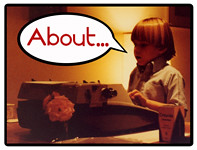Well even though I’ve been sort of quiet of late on the podcast front here at Branded, I did manage to end up as a guest on another show, namely the awesome Make Like a Tree Comics podcast, which is a forum for Jerzy Drozd and Sara Turner to take readers behind the scenes on the comic books they both write and draw. Jerzy wanted to start a discussion on the concept of All Ages material (stuff like super hero comics, cartoons, etc), so he invited Mark Rudolph of Control Voice Comics (CV Comics for short) and myself to a roundtable discussion on the topic (the mighty Hoover was also invited as he’s a great friend of Jerzy and a bastion of knowledge on the subject, but unfortunately he couldn’t make it), which we only really hit the tip of the iceberg.
You can find the episode on the MLaT Talkshoe page; it’s Episode 16, All Ages for All Ages. While you’re there I urge you to check out the other episodes where Jerzy, Sara & Hoover talk about the MLaT family of comics (like The Front and File 49), as well as heading over to the MLaT site and reading the comics and checking out Mark’s stuff at CV Comics.
Since we mainly tried to focus on what we enjoy about the concept of All Ages material on the podcast I thought I’d add a little bit to the idea here by mentioning a few of the misconceptions of All Ages stuff. I’ll be honest, I tend to be guilty of having that initial gut reaction to the phrase, the one where all I imagine is Mr. Rogers or the Sesame Street movie (Follow That Bird) and I tend to forget that All Ages doesn’t mean "For Kids Only" which is sort of the rap it’s been stuck with. I don’t want to speak for everyone, but I believe that a lot of people have this reaction and I was trying to think of why that is. The best conclusion that I could come up with is that since the birth of film and comics there’s been a push to segregate media due to its suitability for children and over time it’s cemented this false notion that there are things for kids and things for adults and neither the twain shall meet. I mean if you take a gander at the whole Comics Code Authority debacle, the Hays code days, or the inception of the MPAA ratings system you can get an idea of how the idea of keeping adult material out of the hands of kids has shifted to creating content geared towards specific age groups.
For instance, using movies as an example, from 1968 through about 1984 the majority of films produced by Hollywood fell under either the G or PG (formerly GP) rating, so films like Rocky & Airplane! were rubbing shoulders with flicks like The Black Hole and The Black Cauldron. I’m not sure how long since any of you have seen Airplane! but it’s pretty raunchy, I mean it’s got BJ jokes for crying out loud and it’s rated PG! But then, after Spielberg unleashed Temple of Doom and his produceorial effort Gremlins on the public parents groups got their panties in a bunch and started writing letters about how much of a travesty it was that these films were PG (now remember, PG more or less stands for Parental Guidance, which translates into suitable for some children, but not all and ultimately it’s up to the parents to decide, which these groups can’t seem to handle.) So Spielberg suggested to Jack Valenti that a new rating be created, a PG-14 that would indicate that maybe pre-teens shouldn’t be admitted alone.
Well Valenti and the MPAA settled on PG-13, and from then on Hollywood began to change. See PG-13 usurped aspects of both the PG and R rating in such a manner that with the exception of full frontal nudity and extreme bloodshed and language most films began to fall under the new rating. Because of this studios realized that if they toned down more adult fare they could now broaden their viewing audience on about 80% of their pictures, so for the first time in a number of years the studios began to take a heavy hand in the artistic side of things and pushed for a targeted and specific output from writers and directors trying to get flicks that met the expectations of the widest audience possible.
Well at the same time the public began reacting to these changes as well, and soon enough kids who were used to what would have fallen under the PG rating were now looking to PG-13 and PG gained a reputation for being "for kids", something to graduate out of. Films that were more or less for adults that were now slapped with a PG rating began to be ignored, the audience thinking it must be bad or "written down to a kid’s level." A perfect example of this is the film Sky Captain and the World of Tomorrow.
As for comics, after the CMAA introduced the Comics Code Authority with was a self censoring seal of approval that basically stated that the material in the comics was free from anything violent, gory, crime laden, horror filled, or sexy. The major publishers all adopted the comics code for the most part and from then on the comic book medium became synonymous with "being for kids" and honestly the publishers didn’t help by more or less writing down to a child-like level.
This mentality has pervaded into the collected subconscious to such a degree, that it’s become a common misconception to think that certain things are for kids, e.g. anything without extreme violence, without heaps of bad language, or tons of boobie shots. Think about all of the comic book flicks that have been hitting theater screens for the last 7 years, and try and come up with the one major complaint from most filmgoers. The one I hear the most is that these films aren’t realistic because they aren’t gritty, don’t have enough real action, and there aren’t in-depth convoluted stories. Hell, I’m just as guilty. When I think of the perfect Captain America movie for me, all I can imagine is Cap thrown into Saving Private Ryan, but with more red-skull-exposed Nazis running around for him to smack upside the head with his shield.
Anyway before I get off onto a rant about which is the right way to handle comic book properties, I have to say that neither, or more accurately both, are right. What we’re missing in the world today is a tolerance for both mature and all ages material and that it’s okay to like one, both or neither, and that’s not what I see most of the time.
Anyway, getting back to the MLaT podcast that I was a guest on, what would you say are some of the aspects of All Ages media that intrigue you the most?






















